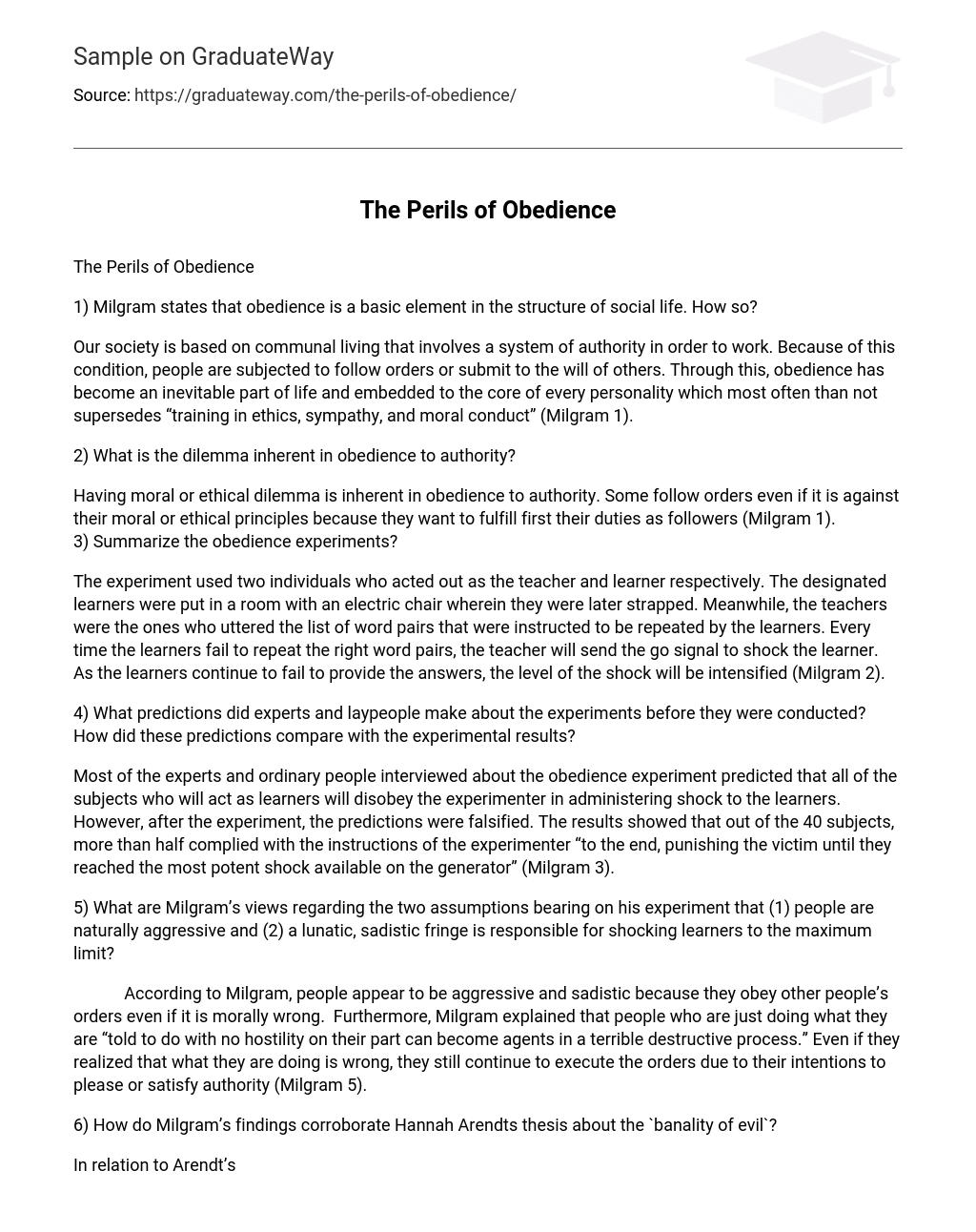1) Milgram states that obedience is a basic element in the structure of social life. How so?
Our society is based on communal living that involves a system of authority in order to work. Because of this condition, people are subjected to follow orders or submit to the will of others. Through this, obedience has become an inevitable part of life and embedded to the core of every personality which most often than not supersedes “training in ethics, sympathy, and moral conduct” (Milgram 1).
2) What is the dilemma inherent in obedience to authority?
Having moral or ethical dilemma is inherent in obedience to authority. Some follow orders even if it is against their moral or ethical principles because they want to fulfill first their duties as followers (Milgram 1).
3) Summarize the obedience experiments?
The experiment used two individuals who acted out as the teacher and learner respectively. The designated learners were put in a room with an electric chair wherein they were later strapped. Meanwhile, the teachers were the ones who uttered the list of word pairs that were instructed to be repeated by the learners. Every time the learners fail to repeat the right word pairs, the teacher will send the go signal to shock the learner. As the learners continue to fail to provide the answers, the level of the shock will be intensified (Milgram 2).
4) What predictions did experts and laypeople make about the experiments before they were conducted? How did these predictions compare with the experimental results?
Most of the experts and ordinary people interviewed about the obedience experiment predicted that all of the subjects who will act as learners will disobey the experimenter in administering shock to the learners. However, after the experiment, the predictions were falsified. The results showed that out of the 40 subjects, more than half complied with the instructions of the experimenter “to the end, punishing the victim until they reached the most potent shock available on the generator” (Milgram 3).
5) What are Milgram’s views regarding the two assumptions bearing on his experiment that (1) people are naturally aggressive and (2) a lunatic, sadistic fringe is responsible for shocking learners to the maximum limit?
According to Milgram, people appear to be aggressive and sadistic because they obey other people’s orders even if it is morally wrong. Furthermore, Milgram explained that people who are just doing what they are “told to do with no hostility on their part can become agents in a terrible destructive process.” Even if they realized that what they are doing is wrong, they still continue to execute the orders due to their intentions to please or satisfy authority (Milgram 5).
6) How do Milgram’s findings corroborate Hannah Arendts thesis about the `banality of evil`?
In relation to Arendt’s thesis about the ‘banality of evil,’ Milgram have concluded that this idea that ordinary people can become evil by simply abiding directives. In the experiment, most of the subjects shocked the learners “out of a sense of obligation-an impression of his duties as a subject and not from any peculiarly aggressive tendencies (Milgram 5).
7) What, according to Milgram, is the `essence of obedience`?
The essence of obedience is that an individual realizes that he or she is only an instrument in the manifestation of other people’s will. Because of this, that individual thinks that he or she does not possess any responsibility for whatever consequences that her or his actions may bring (Milgram 6).
8) How did being an intermediate link in a chain of action affect a subject’s willingness to continue with the experiment?
Because of the intermediate link in a chain, the responsibility attached in following directions can easily be ignored because for the subject, there are other people who are directly involved in the experiment who are directly inflicting pain to the learner (Milgram 7).
9) In the article’s final two paragraphs, Milgram speaks of a `fragmentation of the total human act. To what is he referring?
In the last part of the article, Milgram argued that because of the changing times, people have altered their viewpoints on how they see and understand the complexities of life. Most of the time, people do not notice the whole situation. They only see a small snippet which adversely affects their ability to act with direction or purpose. In short, people “yield to authority but in doing so, they are alienated from their own actions” (Milgram 7).
Summary of the article
In The Perils of Disobedience, Milgram explained how humans are capable of hurting other human beings by merely obeying authority. Obedience is an unavoidable episode in people’s lives. However, disobedience comes into play when a moral or ethical dilemma is presented and when the authoritative figure shows a weak spot or fragile stature. Moreover, people’s level of reaction to authority can vary depending on the mindset and personality of an individual. But most of the time, they will yield to authority. In the experiment, many followed the instruction of the experimenter even if the learner was already in pain. Some of the participants complained and tried to reason out with the experimenter but in the end they still followed his orders. More so, the expression of aggressiveness and sadism are only evoked by the simple act of following orders and not by a conscious effort to demonstrate power. Overall, Milgram made an interesting discovery when it comes to people’s reactions when subjected to authority. Human beings will continue to respond to authority because obedience is an essential element needed to shape an effective and meaningful social life.
Work Cited
Milgram, Stanley. “The Perils of Disobedience.” Harper Magazine December 1973: 1-7.





